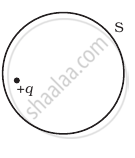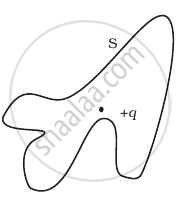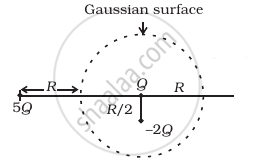Advertisements
Advertisements
प्रश्न
A thin conducting spherical shell of radius R has charge Q spread uniformly over its surface. Using Gauss’s law, derive an expression for an electric field at a point outside the shell.
उत्तर
According to Gauss law,
`epsi_0EointdA=q`
Where,
q is the point charge
E is electric field due to the point charge
dA is a small area on the Gaussian surface at any distance and
`epsi_0` is the proportionality constant
For a spherical shell at distance r from the point charge, the integral `ointdA` is merely the sum of all differential of dA on the sphere.
Therefore, `oint dA =4pir^2`
`epsi_0E(4pir^2) = q`
or `,E = q/(epsi4pir^2)`
Therefore, for a thin conducting spherical shell of radius R and charge Q, spread uniformly over its surface, the electric field at any point outside the shell is
`E = Q/(e_0 4pir^2)`
Where r is the distance of the point from the centre of the shell.
`E = q/(4piepsi_0r^2)`
APPEARS IN
संबंधित प्रश्न
State and explain Gauss’s law.
A charge Q is placed at the centre of a cube. Find the flux of the electric field through the six surfaces of the cube.
Answer the following question.
State Gauss's law for magnetism. Explain its significance.
Gaussian surface cannot pass through discrete charge because ____________.
q1, q2, q3 and q4 are point charges located at points as shown in the figure and S is a spherical gaussian surface of radius R. Which of the following is true according to the Gauss' law?

The Gaussian surface ______.
The Electric flux through the surface
 (i) |
 (ii) |
 (iii) |
 (iv) |
Consider a region inside which there are various types of charges but the total charge is zero. At points outside the region
- the electric field is necessarily zero.
- the electric field is due to the dipole moment of the charge distribution only.
- the dominant electric field is `∞ 1/r^3`, for large r, where r is the distance from a origin in this region.
- the work done to move a charged particle along a closed path, away from the region, will be zero.
Refer to the arrangement of charges in figure and a Gaussian surface of radius R with Q at the centre. Then

- total flux through the surface of the sphere is `(-Q)/ε_0`.
- field on the surface of the sphere is `(-Q)/(4 piε_0 R^2)`.
- flux through the surface of sphere due to 5Q is zero.
- field on the surface of sphere due to –2Q is same everywhere.
The region between two concentric spheres of radii a < b contain volume charge density ρ(r) = `"c"/"r"`, where c is constant and r is radial- distanct from centre no figure needed. A point charge q is placed at the origin, r = 0. Value of c is in such a way for which the electric field in the region between the spheres is constant (i.e. independent of r). Find the value of c:
